In a world crawling with nostalgic re-creations, facsimiles and replicas of America’s small-town ethos and bootstrapping character, there is still a place you can find the real thing. You might see it in a single building in Minot or a high-tech farm in the Red River Valley. It’s visible in downtown Fargo, and in the feverish but focused oil-patch town of Watford City. And it’s evident in the eyes and actions of the people: North Dakota shines with authenticity.
It’s a place where seeding the future still means something quite literal. Energy may rule the headlines, but ag still rules the roost, employing 24 percent of the state’s population in related industries and driving some $4 billion in cash receipts. No wonder the state’s new Latin motto translates to “One sows for the benefit of another age.” One multinational corporate executive gets that motto, and his company appears to be living it out:
“I’m a bit biased in that I’m a North Dakotan by birth,” says Greg Page, CEO of Cargill, “but it is a wonderful place to grow up and a great place to do business. Whether you’re a new business, an expanding business or an entrepreneurial endeavor, the state takes real pride in fostering an environment that helps companies and industries thrive.”
Cargill currently has more than 550 employees in seven locations throughout the state. Last year, with the help of Greater Fargo Moorhead Economic Development Corp., the North Dakota Department of Commerce and the West Fargo Economic Development Association, Cargill pledged more than $50 million toward the rebuilding and expansion of its oilseed processing plant in West Fargo.
“We’re so optimistic about our future in North Dakota that we’re actively involved in a wide variety of community enrichment activities, from working with the University of North Dakota to engaging elementary and secondary students in science and engineering activities,” says Page.
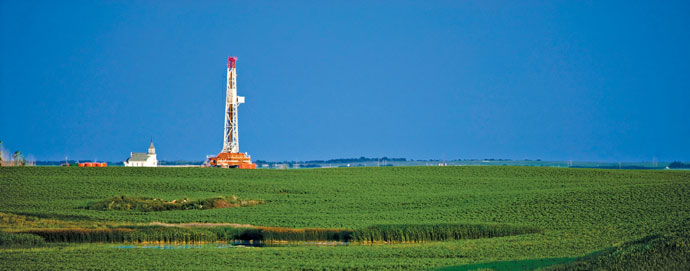
The welcoming tradition goes back at least to the Mandan tribe, whose leaders pitched Meriwether Lewis on locating in the state when the Lewis & Clark expedition passed through in November 1804. Both the Mandan and Hidatsa tribes offered to help the group, and the Mandans got the contract, says historian and author Clay Jenkinson during a talk at the Lewis & Clark Interpretive Center along the banks of the Missouri River. The expedition spent more time in North Dakota than in any other state — 146 days — due to a blend of hospitable people and, well, sometimes less than hospitable weather.
Easy familiarity is still a state attribute.

“In North Dakota it doesn’t take long to get everybody organized and in conversation,” says recent transplant Dean Bresciani, president of North Dakota State University. In his former state, “I knew the governor but the appointment might take three months. Here I know the governor and his wife Betsy, and have his cellphone number.” Not only that, he says, but he’s a governor “who taught himself Greek so he could read ‘The Iliad’ in the original.”
“People joke that everybody knows everybody,” says Rich Garman, senior project manager, business development, for Great River Energy, which is marketing a huge industrial park property adjacent to its 1,100-MW combined heat and power plant next door to Cargill’s malting plant in Spiritwood. “But they probably do.”
The possible recovery of up to 24 billion barrels of oil equivalent from the Bakken shale formation in the state’s northwest quadrant, combined with the state’s German heritage, means that the state’s easy familiarity has extended right to the German-born pontiff himself.
“A relatively new bishop in the diocese in Bismarck was trying to gather some understanding of the communities in western North Dakota to determine resources locally for humanitarian services,” relates Paul Lucy, director of the economic development & finance division of the North Dakota Department of Commerce. “We briefed him with what information we had. We later learned that when he met with the pope and was introduced as being from this diocese, the pope said, ‘Ah, the Bakken.'”
Human Capital: The Strongest Crop
But a sizeable chunk of the 65,000 jobs created in the state in the past decade aren’t necessarily focused on oil & gas. “Enterprising States,” a June 2012 report prepared for the U.S. Chamber of Commerce’s National Chamber Foundation, noted, “Among the current 16,000-plus job openings in North Dakota, 60 percent are found outside of oil-producing counties, many in manufacturing, technology, or advanced services sectors.”
“We had budget reserves before all of the oil industry growth,” says Lucy. “Even factoring out the mining and extraction industries, we still lead in GDP growth.”
Al Anderson, commissioner of the North Dakota Department of Commerce, says the five primary industries targeted by the state a decade ago — energy, value-added agriculture, advanced manufacturing, technology-based businesses, and tourism — are thriving.
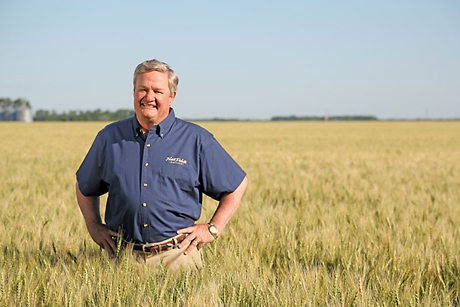
“We have companies coming here because they have done their research,” says North Dakota Gov. Jack Dalrymple, noting recent advanced manufacturing investments from Caterpillar, Deere & Co. and Doosan’s Bobcat business, all longtime investors in the state who have been catalysts for clusters and centers of excellence. “There’s nothing better on the job creation front than technical innovation,” he says. “So we really are excited to have companies like Cat, Deere and Bobcat conducting R&D and developing new products in North Dakota. That’s what you want in your economy.”
The Power of People
Innovation begins with a mindset.
“The primary advantage and strength available to us centers around having access to a wholesome, dedicated work force,” says Bill Burga Jr., the globally experienced head of Manufacturing Americas for LM Wind Power Blades, which maintains a large manufacturing and research operation in Grand Forks. “The character of everything we are and everything we do is defined by the quality of our people.”
There are other advantages too, he notes, among them the access to navigable highways, land and water, and two great universities, as well as the aggressive support of the Grand Forks Region Economic Development Corp., city council and mayor, “all enclosed in a green, bicycle-friendly city.”
“It’s a very pro-business state,” says Martin Purdy, facility manager for Caterpillar’s Reman Components Division in West Fargo. “Access to officials and government folks is just a phone call away,” and the follow-up visit happens shortly thereafter. What a visitor sees when he gets to the plant is a no-nonsense work force.
“They are very in tune with doing work,” says Purdy, who’s overseeing a 225,000-sq.-ft. expansion and consolidation of the facility, the only location in North America that remanufactures drivetrains for large mounted trucks that operate at mines and energy sites around the world. Purdy says the plant has added just under 100 employees over 18 months, and employment is projected to grow from the current 390 to between 450 and 500 over the next two years.
State support from the Department of Commerce has helped, as has work-force training and development support from the state’s manufacturing extension partnership (www.ndmep.com) and support from the state’s robust Job Service North Dakota program (jobsnd.com).
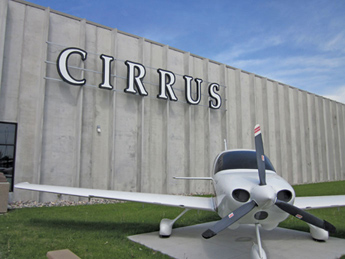
Purdy is one of many leaders who point to a strong mechanical aptitude and knowledge base that’s largely attributable to a farm upbringing. The work ethic that comes with that upbringing is generally without peer. As one observer puts it, “If somebody is unemployed, they really don’t like being unemployed.”
Bryan Brossert, vice president of operations for Phoenix International, a John Deere company that makes high-value electronic components for farm and other machinery, likes his company’s low turnover in Fargo. That applies to himself, as he originally planned to stay a maximum of two years when he moved from Texas.
“Now it’s been six, and I don’t plan to go anywhere,” he says.
Deere & Co. is investing $22 million in a new 90,000-sq.-ft. building nearby. The new structure will increase the total number of Phoenix International facilities in the Fargo area to six with a footprint of more than 300,000 square feet. Phoenix currently employs more than 900 people in the Fargo area, including at a new product-engineering center on the campus of North Dakota State University. The company’s president, Tom Budan, presided over the groundbreaking last fall just after taking the position and moving from Waterloo, Iowa.
“The transition was very good for me and my family,” Budan says. “Great schools, great community. Two of my children are in elementary school, and we find the school district very strong. As we recruit and try to attract the level of talent we need to grow our business, we emphasize the richness of the community from a social standpoint, a cultural standpoint, and for those who are raising families. It’s a very easy story to tell. Once we get them here, we have a pretty good record of keeping them. When you’ve had the kind of success we’ve had here in all aspects of the business, it’s a feather in the cap of the community, and it’s easy to continue to grow.”
One aspect that might surprise some is the global reach of the airport. Budan traveled some 75,000 miles in his first six months on the job, visiting plants in Mexico and India as well as traveling to China.
“The Fargo airport is a real gem,” he says noting strong connections with international hubs in Denver, Minneapolis-St. Paul and Salt Lake City. Being at the intersection of two major Interstates helps the company’s goods travel effectively as well. And the whole package has left its mark on others within Deere & Co.
“I believe our operation here in Fargo has been a very good example of business expansion within our corporation,” says Budan. Though other divisions have their own centers of locational gravity, “those who have come up here and seen our operation and talent have always been very impressed by what they see.”
Close Ties Generate Global Affinities
Debra Anderson is president of Summers Manufacturing, a farming machinery manufacturer based in Maddock, but which does much of its business out of its complex in Devils Lake, which has expanded four times in the past eight years.
“It’s collaborative, and supportive,” Anderson says of the state and local business climate. “I don’t ever remember any time when we’ve been faced with something and we haven’t gotten help from either the state or the community,” the latter represented by Forward Devils Lake.
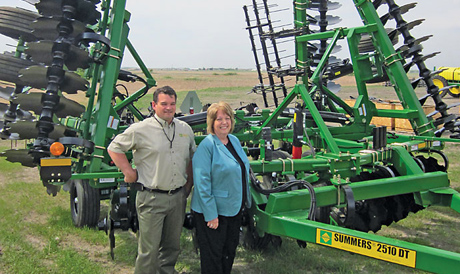
A major assist comes from the unique Bank of North Dakota (BND), which partners with local community banks throughout the state on a number of business development and loan programs, including Partnership in Assisting Community Expansion (PACE) loans for manufacturers, processors, data processors and communications firms.
Eric Hardmeyer, BND president, says the bank has caught its share of national and international attention as North Dakota’s dynamic economy has been the outlier to everyone else’s tough times. The bank is not only profitable, but returns part of its profits, pouring $350 million back into the state’s general fund over the past few years.
“Our job at the Bank of North Dakota is to be financiers of the state’s economic development efforts,” says Hardmeyer during an interview in the office of Gov. Jack Dalrymple. “That’s why we were created 90 years ago — to enhance North Dakota, whether it be educational opportunities or big primary-sector projects.”
It’s all driven from the bottom up, as municipalities and local banks originate loans, and BND comes in to participate, backed by what now amounts to $5.5 billion in assets.
BND’s mission is consistent with a general sense of fiscal responsibility that is as fundamental to North Dakotans as their belief in strong public education. The state is the only one in the nation not to have had a budget shortfall in the past four fiscal years.
“Thirty percent of oil and gas taxes go to a legacy fund that can’t be touched until 2017,” says Department of Commerce Commissioner Al Anderson. “There is $1.2 billion set aside for water and sewer and roads. And we have a regulatory environment that brings everybody to the table to find solutions. It all has something to do with our size.”
Gov. Dalrymple grew up on the family farm in Casselton established in 1875 by his great-grandfather. He was the founding board chairman of Carrington-based Dakota Growers Pasta Co., and earned the 2007 Ernst and Young Midwest “Master Entrepreneur of the Year” Award. So he knows whereof he speaks when it comes to business, and BND’s leading role.
“I was on the board of the Casselton bank, and saw this from the other side,” he says. “Somebody needs a $200,000 loan to expand. We sit around and talk about it, trying to work up our courage. And somebody says BND will take half of it. Then everyone says, ‘I vote in favor.’ “
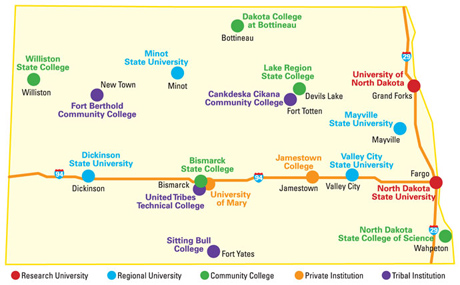
“The PACE loans enabled us to do all these expansions at reasonable costs,” says Summers Manufacturing’s Debra Anderson in Devils Lake. “We’ve done one in Maddock as well. Both communities have been more than willing to step up.”
That’s in keeping with the company’s roots. Anderson says her father, who was originally a blacksmith, raised his original funds for manufacturing in large part due to support from local farmers who believed in him.
“All of our engineers were either farmers or raised on a farm,” says Brian Perkuhn, sales manager at Summers. “It’s the family farm as R&D lab.”
Asked if skilled labor is a challenge because of the oil & gas draw in the west, Perkuhn says it’s helped more than hurt. Anderson confirms that a welder just joined the company from out in the oil patch the week before. New talent recently has signed on in Devils Lake from Texas, Michigan and New York.
“The individual from New York stated that he really didn’t know what farming was all about because he was from the inner city,” Anderson says. “He loved the landscape. He said he’s never going back.”
Homes on the Plains
Microsoft located a major customer service and support center in Fargo in 2001 when it acquired homegrown Great Plains Software for $1.1 billion. Microsoft anticipates having 900 employees by the end of June 2012, which added to over 800 contract staff on site makes the Fargo operation one of the company’s 10 biggest sites by head count in the world. It’s a crucial site too: Some 45,000 Microsoft employees get paid via the work accomplished there. The company’s Fargo facility shares a large development lab with sites in Denmark and India, and is home to one of Microsoft’s 12 executive briefing centers.
Katie Hasbargen, Ph.D., is senior communications manager and program lead for Microsoft Business Solutions in Fargo. She says the area is great for feeding talent from colleges, and points to another talent indicator: the Microsoft designation of “distinguished engineer.”
“There are 38 of them in the whole company,” she says. “Three live outside Seattle, and two live in Fargo, and they’re both North Dakota State University graduates.”
In December Microsoft announced it had chosen Hitachi Consulting to supplement its Microsoft Business Solutions IT team located in Fargo. A new technical development center will be located on Microsoft’s campus, and Hitachi eventually will migrate to its own building in town.

Gov. Dalrymple attended that announcement, and was again present in Fargo in late July, when he helped Sanford Health break ground on a new $541-million, 1.2-million-sq.-ft. medical center that will create 2,700 jobs. Located on over 100 acres in a growing area of southwest Fargo, the new site provides the space and capacity for future expansion.
Sanford Health, based in both Fargo and Sioux Falls, S.D., is the largest, rural, not-for-profit health care system in the nation with a presence in 112 communities in seven states, including 20,000 employees in the Dakotas alone. Dennis Millirons, president of Sanford Medical Center Fargo, calls the new project on I-94 the only integrated campus of its size between the Twin Cities to the east, Omaha to the south, and the West Coast. There are a lot of strategic reasons why the project makes sense. But the intangibles may carry the day.
The Fargo flood of 2009, like the 1997 flood in Grand Forks, has left indelible marks, but also has demonstrated the indelible resiliency of North Dakotans. The flood of ’09 happened when it was 15 degrees below zero. But that didn’t prevent people from getting out to make sandbags: 6 million of them, along 80 miles of levee.
“Here, when there’s a Code Red, so many people show up you have to turn them away,” says Millirons. “Culture trumps strategy every day.”
Stewardship in Action
In June, National Information Solutions Cooperative (NISC), a provider of IT products and services to utilities and telecom organizations, was listed by IDG’s Computerworld magazine as one of the 100 best workplaces for IT professionals in the United States for the 10th time. More than 600 companies, led by electric cooperatives, use NISC’s advanced IT systems.
NISC’s team of more than 920 individuals includes locations outside St. Louis, Mo.; in Shawano, Wis.; and Cedar Rapids, Iowa, but its headquarters has always been in Bismarck’s twin city of Mandan, where the company and over 400 employees are led by President and CEO Vern Dosch.
“We travel around the country, and you should see the looks we get — a technology company in Mandan, N.D.?” says Dosch. He says 2008-2011 were among the best years NISC has ever had, and the current fiscal year is the best in company history. NISC has started leasing space next door as it continues to grow. “Every couple years we add another 20,000-square-foot pod,” he says, “and we have purchased land to the east.”
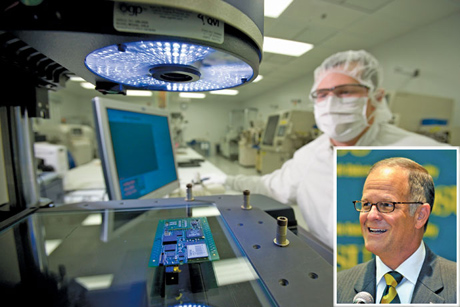
Funds from state programs and loans from BND have helped NISC create 106 jobs. The state’s New Jobs Training program recently was made more user-friendly so a company can receive the funds and then self-finance the work-force training.
Dosch says NISC’s operation has had some success recruiting among the Apples and Googles of the world. “Longevity is kind of our ace in the hole,” he says, “coupled with the incredible talent we’re getting out of the universities right now.”
Also among the strengths of Mandan is a solid fiber connection with NISC’s operation outside St. Louis, which serves data storage redundancy needs. That helps in serving customers such as Great River Energy as the smart grid takes shape and the days of walk-by analog meter readings fade.
“We’re getting all of that data, and storing it on behalf of our customers,” says Dosch, noting that the high-level connectivity in North Dakota gives the company “as big a pipe as we’d need.” The firm is managing about 4 billion meter readings, and it’s growing by 1 billion readings a month. “It’s the data making the grid smarter, and we’re the stewards of that data.”
Dosch says the wage differential for light technical personnel is six percent less in Mandan than outside St. Louis. The differential jumps to 15 percent for software developers when compared to Minneapolis. Construction costs per square foot for a recent expansion in Missouri were 25 percent greater than what the company paid for its last expansion in Mandan in 2009.
A Place To Grow
Kari Reichert, assistant general counsel and vice president of people services for NISC, is a western North Dakota native and Yale Law School graduate who came back home to practice law after living in several big cities. She says one of the great attributes of NISC staff is their non-technical backgrounds. “Jared in technical services got the call for a job offer and said ‘Hold on, let me turn off the tractor,’ ” she says.
NISC sells its culture and shared values to compete with career opportunities in the Twin Cities, Chicago and Phoenix. Turnover hovered at a mere 3 percent as recently as 2009.
|
DID YOU KNOW?
According to the Resilience Capacity Index developed by Kathryn Foster, PhD, director of the University of Buffalo Regional Institute, Bismarck-Mandan, N.D., ranks No. 1 in the nation in community connectivity, reflecting scores on four underlying indicators of resilience capacity: civic infrastructure, metropolitan stability, home ownership, and voter turnout. |
“Sometimes it’s hard to compete for some of the students, but the nice thing is most of those kids want to eventually come back,” she says. Her own return has meant a five-minute commute to work, and living within a block of her son’s school.
“Boomerangers” are part of a demographic trend that helped the state finally surpass its 1930 Census population mark in 2010. Now the population is approximately 700,000. At the rate things are going, some are whispering about the magic figure of 1 million.
Even more important, says Commerce Commissioner Al Anderson, is the makeup of that population.
“An aging population is a challenge for the entire country,” he says. But in the last several years, North Dakota has increased its under-35 population dramatically. “That is one thing that is going to be our strength,” he says.
“You live here for a reason,” says Dosch, and for many that reason is interaction with the natural world. “I live on the Missouri River, and have the good fortune on occasion, on a nice summer day, to slip my kayak into the river, paddle across, get on my bike and ride into work. For a lot of people, it’s family, quality of life and educational institutions — sending kids to a high school like the one whose graduation I attended yesterday, where 99 percent go on to college.
“A lot of people here are from small-town North Dakota,” he says. “Any one of them could probably go to Minneapolis and make more. But a lot of those employees would rather take some stability over the highest offer. Think about stability and the tech industry — it’s almost an oxymoron. But this is a company that’s grown every year for the past 47 years.”
Momentum in Magic City
Minot, a city of 50,000 in north-central North Dakota, is home to a 13,000-person Air Force base and a university — Minot State — that contributes nearly $200 million annually to the economy. Minot has become a preferred location for oil & gas-related company headquarters, and the rate of hotel construction is in keeping with a state that since 2010 has seen 45 new hotels open, adding 3,257 rooms. But again, it’s not all about oil.
Eid Passport, a technology company based in Portland, Ore., is focused on identity management services, and its signature technology is used by several federal agencies. The firm is led by Minot native Steve Larson. The company chairman and CEO wanted to give something back, and found a favorable, progressive business climate in downtown Minot for the opening, in November 2011, of a new 50-person technical support office in a former YMCA building. The opening was a breath of fresh air in a city that was ravaged by a flood earlier in the year.
The building renovation is designed to house up to four new businesses. The state has committed more than $1 million for the project with funding from the Community Development Block Grant, the North Dakota Development Fund and the New Venture Capital Program.
But Larson’s team did not stop there. They looked at the housing shortage locally and statewide, they looked at unused parking lots downtown, and they saw an opportunity to introduce hundreds of new in-town apartments to the city’s core.
“We were granted rights to seven to eight sites for surface parking lots to turn them back into mixed use and reactivate downtown,” says Gary Reddick, president of V3 Studio, the architecture and design firm working with Eid Passport.
The plan would see up to 1,200 units developed over the next three to five years. Helping revitalize the city after nearly $1 billion in flood damage will be $22 million in federal funds through the U.S. Economic Development Administration. But even with the flood, things have been going gangbusters.
“Last year we did $200 million in permits for construction in the city, double what we did the prior year,” says Jerry Chavez, president and CEO of Minot Area Development Corp., and this year is already ahead of last year.
V3’s Reddick has seen his share of downtown revitalization efforts.
“Not every downtown is remakeable,” he says. “Minot’s is.”
Growth is also occurring on Minot’s perimeter. North Dakota Port Services has big plans for Minot’s intermodal facility in the next few years. The completed project will have 45 miles of new track, and the site would generate 4,000-7,000 truck trips daily with another seven unit trains per day at the port. “The size and scope of this project will represent the largest investment in a rail distribution transportation hub in North Dakota,” Chavez says.
The Catch-Up Opportunity
If the croprows in the Red River Valley are as straight as technically possible, the beeline to the future in western North Dakota has a few more twists and turns. And it’s not just because that’s the topography of the badlands.
The pace of activity is literally feverish. Just ask Gene Veeder, economic development director for the McKenzie County Job Development Authority, based in hectic Watford City. He’s getting over the cold that everybody seems to have caught recently. But that doesn’t hide his contagious excitement about his hometown.
“I might talk to five or 10 CEOs a week about multimillion-dollar investments,” he says. “We’re playing catch-up, with a lot of interest in retail. We need that in order to get to any next step with economic diversification.”
Meanwhile, the push for basic construction materials and labor is driving the cost for current commercial projects in town to $16 per sq. ft., says Veeder. Water trucks serving the oil sites wait in line to get water from a single municipal well spigot. Nearby a food truck waits to serve the truck drivers.
“The speed of growth is challenging our housing and infrastructure,” says Paul Govig, deputy commissioner of the North Dakota Department of Commerce and director, division of community services. “We’re making progress, but if there is one bottleneck, it’s the housing issue.”
The bottleneck is being cleared one project at a time. In Watford City, the Pheasant Ridge development was recently annexed into city limits, and will feature both single-family and multifamily residences on a 36-acre parcel.
In Tioga, Hess is investing $350 million in an expansion of its gas plant, including a rail siding with room for 100-car unit trains that looks like a racetrack at night. It might as well be. Two new crew camps that house more than 3,000 oilfield workers face each other across a busy highway outside town. Kathy Neset is a geologist who heads a growing energy-consulting firm based in Tioga.
“It’s a difficult balancing act we have going here,” she says. “Polls have shown that North Dakotans are very proud of their ability to add to the national security by developing our national energy here. It secures our future. That being said, we have to deal with the cost, which is a change in the quality of life, whether the cost is in dollars, lifestyle, privacy or safety.”
Then again, she has two children working in her field who make a very healthy income just a year out of college. And she’s encouraged by two trends joined at the hip: better technology and less environmental disturbance. Staged fracking, with constantly improving tools, enables more oil recovery while also allowing the land to recover — or to not be disturbed in the first place. She recalls assigning herself to a drill rig site, and walking a land section line.
“I could see my rig off to the west, and it dawned on me that the azimuth of the wellbore had passed underneath the ground I was standing on. The drill bit was half a mile away, and the rig was steering the 6-inch bit from another mile off. It drains 1,280 acres. But the surface disturbance is incredibly less than it used to be. It’s amazing.”
Communities outside the oil patch are doing their part to back up the growth. Bismarck-Mandan is more than two hours from the nearest rig, but has seen an influx of white-collar employees serving the oil & gas sector. Hess and Halliburton, among others, have placed administrative hubs in Minot.
Meanwhile, mixed-use projects are popping up in small towns such as Crosby, which was losing population not long ago. That was before the town hosted the state’s first successful horizontal well using fracture stimulation technology to drill in the Bakken. Last November, Continental Resources CEO Harold Hamm attended the dedication of a monument erected in Crosby to commemorate that well. Hamm thinks up to 50,000 wells might eventually be drilled to access up to 24 billion gallons of oil equivalent.
Flagships for the Future
Taken together, the approximately 30,000 students at the University of North Dakota in Grand Forks and North Dakota State University’s campuses in Fargo represent the equivalent of more than 4 percent of the whole state’s population. The innovation their campuses hold likewise represents the seeds of the state’s future.
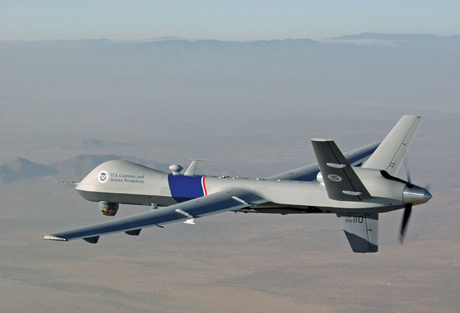
The John D. Odegard School of Aerospace Sciences at the University of North Dakota in Grand Forks is recognized worldwide as a leader in collegiate and contract aviation education. UND is building on that reputation with a new focus on unmanned aircraft systems (UAS).
A first-of-its-kind lease agreement with the Grand Forks Air Base allows UND to train on base with the new Predator Mission Aircrew Training System. Plans call for development of a national center for intelligence, surveillance and reconnaissance (ISR) at the base over the next two years. Earlier this summer, the FAA authorized the use of remote-controlled Predator drones in the airspace above nearly 10,000 acres in the state. UND saw the first graduates from its own UAS program one year ago.
UND’s flight and air traffic control training resources are world-renowned, and have helped the Grand Forks airport become one of the two dozen busiest in the nation, measured by flight operations. Pilots from all over the globe are sent to Grand Forks, resulting in a united nations of flight that builds on a 40-year tradition serving client airlines from such nations as China, Japan, Norway and Saudi Arabia.
“The year we flew 10,000 flight hours, we thought we’d arrived,” says Al Palmer, director of the unmanned aircraft systems center of excellence at UND and one of the flight school’s early champions. “Now it’s 10,000 flight hours a month.”
Michael Moore, associate vice president of intellectual property commercialization and economic development for UND, says the former teachers college’s research expenditures have recently skyrocketed from $30 million to $100 million. And Dr. Joshua Wynne, dean of the medical school and vice president of health affairs, points to an intangible that’s becoming more tangible by the day.
“NDSU and UND are doing the first integrated program for a master’s of public health,” he says. “If healthcare costs aren’t your number one or number two concern, you’re not a good CEO.” North Dakota is above the national average in healthcare quality, he says, and below average in its cost. “You have healthy workers who cost you less than in other environs,” he says, “and have life expectancy above the national average.”
The latest figures back him up: The Gallup-Healthways Well-Being Index released in August ranked North Dakota fifth in the nation in “future livability,” based on 13 metrics measuring economic, health and social wellbeing.
Phil Boudjouk, vice president of research at NDSU, points to the university’s longtime expertise in materials and coatings, which has led to partnerships with companies such as PPG and Akzo Nobel.
At the 55-acre NDSU Research and Technology Park, seven buildings have risen on the site in the past nine years, including a privately owned hotel. Between 2001 and 2010 the university saw its research expenditures increase by 95 percent. Licensing royalties have increased by 61 percent in the past five years.
At R2, the university’s prized research facility, work is active on semiconductor chip packaging, RFID and other specialties. One specialty of R2 is materials characterization. A local connection to that research is alive and visible at the Caterpillar site in West Fargo, where a new lab performs laser cladding and analysis.
“They have thermo-expansion equipment Cat doesn’t have,” says Erica Blizil, metallurgical engineer at Caterpillar. “I’m over at R2 once a month.” Blizil, like many, recently moved back home after trying life elsewhere. The head of the project at NDSU, Rob Siler, is her neighbor.
“Before we got this lab,” she says, “I’d bring home a sample and drop it off with Rob, and get it back a few days later.”
“We have the world’s largest and best equipped lab for robotics for thin-film coatings,” says NDSU’s Boudjouk, a native New Yorker. “We can get to a customer’s parameters better than anyone else, even better than industry.”
But it’s the people of North Dakota who make that industry thrive.
“You’re only one or two degrees of separation from the whole state,” says Great River Energy’s Rich Garman. “And that’s a good thing.”
